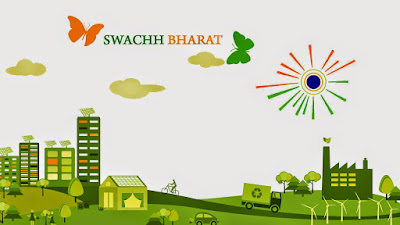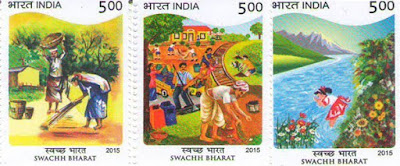By Dr. G G Saxena and Ambuj Saxena
“No, I can’t stay here a minute
longer. It smells too bad!!” Linda said to her husband who was by now tired of
trying to convince her otherwise. Linda’s husband opened a part of the room
curtain, looked at the garbage that was spewn outside the hotel premises, he
further looked at a distance, a slum dweller emptying his bowels in the open.
Then, he looked around in the room at the cozy fireplace, romantic whirlpool
tub, plush king-sized bed and the private balcony. These modern amenities
seemed meagre when compared to the pile of dirt and unhealthy sanitation
practices practiced by people around them. Within half an hour, Linda and her
husband collected their baggage and checked out of the accommodation and started
searching for a Bed and Breakfast accommodation with a clean environment and
modern amenities in the room in that order.
 |
| Swachh Bharat- Clean India |
A tourist likes to explore the
city as well as the place of stay. He/she wanders out to try new cuisine or
catch an event or to know more about the cultural heritage of the city. Here,
cleanliness is assumed to be a given. A foreign traveler’s psyche is affected
by the kind of accommodation offered as well as the locality of the
accommodation. The place of stay leaves a lifelong imprint of the
country/state/place in the mind of the tourist. It helps recommend to the
others about what to expect and what not to expect from the place.
 |
| Travel for fulfilment |
India is a land of natural and
cultural diversity. India ranks 8th in natural resources and 24th
in cultural resources globally. However, it ranks a dismal 42nd in
Foreign Tourist Arrival (FTA) with 0.68% share of Global FTA. This blog
attempts to solve this riddle by analysis cum evaluation of government’s
efforts towards the same and provide a way forward to increase FTA in India.
Why does India suffer
from lack of Sanitation?
This is partly a problem of poor infrastructure of household
toilets, community toilets, non-availability of water in the rural hinterland. A
sizeable population of India is living below the poverty line and lacks the
basic amenities such as water, house, food, toilets etc.
Partly, it is a behavioral problem. If we compare India
with sub-Sahara African
nations, most of the sub-Sahara African nations are way
behind India in terms of macroeconomic indicators such as GDP etc yet these
nations do not have such enormous open defecation problems. Researches have
suggested that apart from poor infrastructure, India’s rigid caste system has
acted as a catalyst to the problem of increase in open defecation. Toilet’s Pit
emptying is assumed to be done by lower cast people and looked down upon by
upper caste hindus’. Thus, merely setting up of toilets does not offer a
comprehensive solution to the issue of open defecation. It needs participation
of a large number of NGO’s and due diligence by the district administrative
workforce to cause change in behavior and encourage use of toilets. For
example, in Rajasthan, district administration workforce has formed effective
links with the local community to alter behavior and to meet the water needs by
District authorities incentivized the participating villages to compete with
each other to make villages open defecation free at the earliest.
Spiraling effects of lack of Sanitation in India
In view of the above, in 2014,
World Bank had called India the hotbed of open defecation. India accounts for
60% global population that defecates in the open. The practice of Open
Defecation is harmful to the entire community as it pollutes the underground
water and increases the risk of water-borne diseases such as Diarrhea etc. In
2014, 300 million cases and 0.3 million deaths due to diarrhea were reported in
children under 5 years of age (RGI 2014).
 |
| Symptoms and Impact of Diarrhea | Source: www.nhp.gov.in |
In the face of low penetration of
health insurance in India (only about 20% population is covered), citizens are
left to fend for themselves to spend their precious savings on healthcare
costs. This leads to catastrophic health expenditure by the poor citizens. It
has been estimated that 70% of urban households’ total out-of-pocket expenditure
is on health while it is 80% for rural households.
Swachh Bharat Abhiyan and its objectives
In light of the above situation, PM
Modi had announced Swachh Bharat Abhiyan (SBA) on 15th August 2014 from
the ramparts of Red Fort. Swachh Bharat Abhiyan is a pan India cleanliness
campaign that aims to make India Open Defecation Free by 2nd Oct 2019
ie. On 150th birth anniversary of Mahatma Gandhi. It may be
remembered that Gandhiji did not feel shy of cleaning the surroundings and
toilets being used by others. Thus, Swachh Bharat Abhiyan (SBA) is inspired
from the noble deeds of Father of the nation. Even the logo of campaign has the
spectacles depicting that of Gandhiji. Thus, SBA includes building household
toilets, community toilets, addressing solid waste management as well as liquid
waste management.
 |
| Sachin Tendulkar, Amitabh Bachchan, Saina Nehwal and other celebrities participating in Swachh Bharat Abhiyan |
Under the Indian Constitution,
Public health and sanitation is mentioned in Entry 6 of State list and Water is
mentioned in entry 17 of the same list. However, water also finds a mention in
Entry 56 of Union List. So it requires effective coordination between States
and centre to fulfill the objectives of the Swachh Bharat Abhiyan.
 |
| Logo- Swachh Bharat Abhiyan |
The Swachh Bharat Mission has the
following 7 key objectives:
1. Elimination
of Open Defecation
2. Eradication
of Manual scavenging
3. Modern
and scientific municipal solid waste management
4. Behavioral
change regarding healthy sanitation practices
5. Awareness
about sanitation and its linkage to public health.
6. Capacity
augmentation of Urban Local Bodies
7. Enabling
environment for private sector participation in CAPEX (Capital Expenditure) and
OPEX (Operation and maintenance expenditure)
Additionally, the financial
structure has also been clearly spelled out. It requires cooperation from the
states as well as private sector participation for sharing financial
requirements as well as planning and execution of the campaign in adequate
measure. Swachh Bharat Cess is being levied to partly meet finances of the
campaign.
Thus, policymakers have done
their part in making the Swachh Bharat Abhiyan policy now it remains to be seen
that the due results take place through effective district administration and
efficient coordination amongst government and private stakeholders.
This was mentioned in my earlier post as
well. Thus, 2 years into the campaign, it needs to be seen if India can be made
Open Defecation Free by 2nd October 2019 as planned by the incumbent
central government.
 |
| Swachh Bharat Abhiyan- Making India Open Defecation Free |
Accomplishments of Swachh Bharat Abhiyan:
It is reported that out of
6,40,000 villages in India, 54,000 villages have been made open defecation
free.
NSSO conducted survey of 73,176
rural households, 41,538 urban households in 3788 villages and 2907 urban
blocks in May 2015. Following were the findings:
·
13% villages have community toilets
·
42% urban wards have community toilets.
·
36% urban area wards have proper liquid waste
management system
·
36% villages have pakki naali and 19% have
katchi naali
·
78% urban area wards have a system of street
cleaning
· 95% persons in rural areas are using sanitary
toilets in their household or community
· 98% persons in urban areas are using sanitary
toilets in their household or community
There are other parameters on
which the performance of SBA can be judged. It can be safely concluded that
within 2 years of the scheme, there have been significant gains with respect to
infrastructure augmentation as well as behavioral change. However, the efforts
need to be multiplied manifold to achieve the target of Open defecation free
India in the remaining 3 years. It requires a greater level of dedication and
commitment to the noble cause not just from Governments at the centre and
states but also proactive engagement by private sector under corporate social
responsibility, other non-governmental organizations and participation of each
and every citizen. This has also been stated by the various Brand Ambassadors
of Swachh Bharat Abhiyan. Thus, we should all take a pledge:
1. I
shall not spit in public and discourage others from doing so.
2. I shall not litter in public and discourage
others from doing so.
3. I shall not urinate in open areas and
discourage others from doing so.
4. I shall not encroach area.
5. I shall not write anything on monuments of
historic significance and discourage others from doing so.
6. I shall use Swachh Bharat Abhiyan stamps whenever I send correspondence to other places.
If each of us follow the pledge, we shall serve
ourselves and the community.
Most importantly, we will be able to sleep
satisfactorily.
 |
| Swachh Bharat Abhiyan stamps |
Swachh Sarvekshan
Ministry of Urban Development
conducted a survey of 73 cities with over 10 lakh population under Swachh
Bharat Abhiyan, called the Swachh Sarvekshan. The parameters were as follows:
·
How cities propose to stop ODF
·
How cities plan to integrate solid waste
management
·
Communication strategies adopted by cities for
behavioral change through information dissemination and education
·
Systems adopted for sweeping, door-to-door
collection and transportation of waste
·
Efficiency in processing and waste disposal
·
Deployment of public and community toilets
·
Progress in construction of individual household
toilets
The 5 most clean cities were:
1. Mysuru
(Karnataka)
2. Chandigarh
3. Tiruchirapalli
(Tamil Nadu)
4. New
Delhi
5. Vishakhapatna
(Andhra Pradesh)
There were other cities out of
the 73 surveyed that were found lacking in the Swachh Sarvekshan parameters and
ended at the bottom of the ranking ladder such as :Meerut
(Uttar Pradesh), Patna
(Bihar), Itanagar
(Arunachal Pradesh), Asansol
(West Bengal) and Dhanbad
(Jharkhand).
Bhopal
city makes an interesting case in the success stories of SBA. Citizen groups in
Bhopal city have not only voluntarily taken up the task to clean slum areas but
are also decorating the walls of the slums and making visually attractive
graffiti.
Swachh Paryatan mobile app has been launched by Min. of Tourism
wherein, domestic and foreign tourists can flag issues related to cleanliness
in and around 25 ASI protected monuments.
 |
| Swachh Paryatan App home screen |
 |
| Swachh Paryatan App screen 2 |
These include Humayun’s tomb, Red
Fort and Qutub minar in Delhi, Taj Mahal in Agra, Rani ki vav in Gujarat,
Kumbhalgarh fort in Rajasthan, Hampi in Karnataka, Konark temple in Odisha,
Thanjaur-Brihadesvara temple in Tamil Nadu etc. If the feedback given by the
users is acted upon promptly, it can lead to cleaner heritage sites of India.
[The app can be downloaded at https://play.google.com/store/apps/details?id=in.org.degs.swachhparyatanapp]
This blog is the second part in
the series of Government schemes directly/indirectly affecting tourism in
India. The first
part was analysis of impact of E-Tourist
Visa scheme on Tourism sector in India.
No comments:
Post a Comment